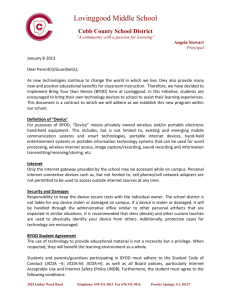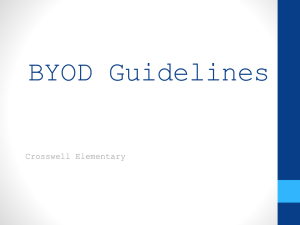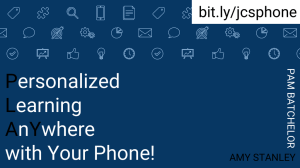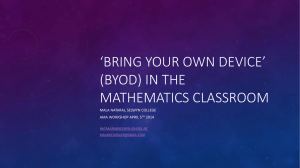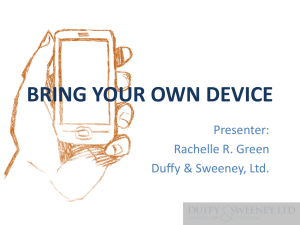Portable Technology - Eramosa P.S. 2015 – 2016
advertisement
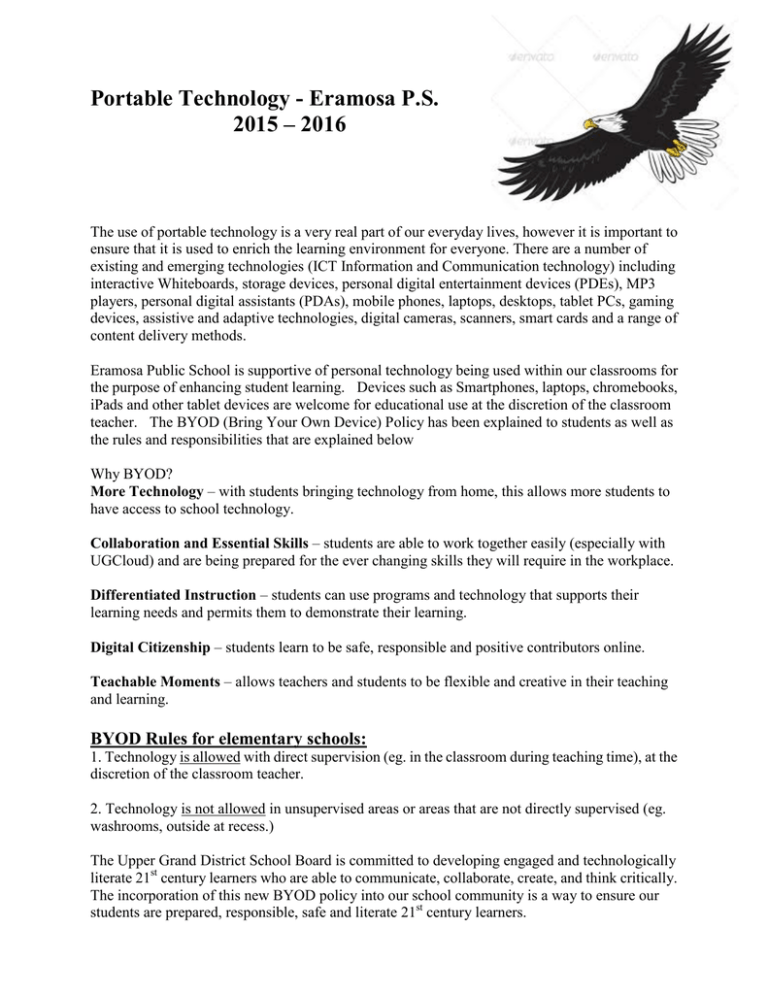
Portable Technology - Eramosa P.S. 2015 – 2016 The use of portable technology is a very real part of our everyday lives, however it is important to ensure that it is used to enrich the learning environment for everyone. There are a number of existing and emerging technologies (ICT Information and Communication technology) including interactive Whiteboards, storage devices, personal digital entertainment devices (PDEs), MP3 players, personal digital assistants (PDAs), mobile phones, laptops, desktops, tablet PCs, gaming devices, assistive and adaptive technologies, digital cameras, scanners, smart cards and a range of content delivery methods. Eramosa Public School is supportive of personal technology being used within our classrooms for the purpose of enhancing student learning. Devices such as Smartphones, laptops, chromebooks, iPads and other tablet devices are welcome for educational use at the discretion of the classroom teacher. The BYOD (Bring Your Own Device) Policy has been explained to students as well as the rules and responsibilities that are explained below Why BYOD? More Technology – with students bringing technology from home, this allows more students to have access to school technology. Collaboration and Essential Skills – students are able to work together easily (especially with UGCloud) and are being prepared for the ever changing skills they will require in the workplace. Differentiated Instruction – students can use programs and technology that supports their learning needs and permits them to demonstrate their learning. Digital Citizenship – students learn to be safe, responsible and positive contributors online. Teachable Moments – allows teachers and students to be flexible and creative in their teaching and learning. BYOD Rules for elementary schools: 1. Technology is allowed with direct supervision (eg. in the classroom during teaching time), at the discretion of the classroom teacher. 2. Technology is not allowed in unsupervised areas or areas that are not directly supervised (eg. washrooms, outside at recess.) The Upper Grand District School Board is committed to developing engaged and technologically literate 21st century learners who are able to communicate, collaborate, create, and think critically. The incorporation of this new BYOD policy into our school community is a way to ensure our students are prepared, responsible, safe and literate 21st century learners. The Acceptable Use of Digital Technology (Policy 318) states, AIt is the Policy of the Upper Grand District School Board to provide safe and secure digital technology for educational and Board business applications. The primary purpose is to support the educational learning experiences of students through research and communication opportunities, and to enhance the business operating efficiencies for administrative purposes. This service is a privilege, not an assumed right. All users must take responsibility for their own actions.@ The Home Use of Assistive Technology Protocol is applicable for those students to whom this applies. Personal Devices may not be used by students at Eramosa PS to call or text anyone unless supervised at the office and for emergency purposes only. Students may not videotape or photograph other students unless there is an educational objective that has been specified by a teacher. To respect freedom of information, video and photo images taken at school functions are not to be posted in public domains by anyone without obtaining prior permission. The Principal has the authority to determine the specific rules for the use of technology in the school and are subject to change. The Principal delegates authority to the specific classroom teacher to use technology in their classroom to improve classroom instruction. Not all teachers will use/permit the same degree of use of portable technology in their classroom. Teachers will clearly outline when and if portable technology is permitted for use in their classroom. These expectations will be clearly communicated to the students by the teacher (supply teacher) on a teacher by teacher basis. This policy will be reviewed with all students. Examples of this might include: - using calculator function on an electronic item - using an electronic item to research a topic using an internet search engine - permitting a student to listen to his/her MP3 player when his/her work is finished If a teacher decides that a student is misusing his/her technology (using it inappropriately, defying the teacher=s decision for example) in the classroom he/she will follow the progressive consequence steps listed below: 1st offence - electronic item is taken to the office for the day and sent home at the end of the day with the student; parent notified of inappropriate use by the teacher Date: ____________ 2nd offence - electronic item taken to the office by the teacher, the parents are phoned by the teacher and a parent will be required to pick up the item from the office (incident recorded by the teacher and the office). Date: _____________ 3rd offence - electronic item is confiscated by the teacher and taken to the office - the student=s privilege to bring the specific item to school is revoked - a letter will document that this is the third incident. The parent will be asked to pick up the item. At this point the teaching environment, the student=s learning (and/or the rights of others) is being compromised. Date: _____________ The use of digital or photographic imagery equipment, including, but not limited to, cell phones, PDAs and cameras is expressly forbidden in all school washrooms and change rooms. Failure to observe this directive will result in the immediate confiscation of equipment and could lead to prosecution by the authorities. At all times, personal technology equipment remains the responsibility of the individuals. At no time will the Upper Grand District School Board be responsible for or accountable for its loss, theft, inappropriate use, or any damage that may occur while on school property. The decision to send this equipment rests solely with the parent/guardian. Digital Respect is at the root of expectations regarding the appropriate use of technological tools. Digital Respect is making a conscious choice to respect others when using any digital devices and services. This includes everything from email to online social sites and mobile phones. Digital Respect is using technology respectfully - that is - not for the purpose of harming others. Digital Respect is often just Agood manners@. There remains little doubt about the power these new tools have to diminish personal communication roadblocks, now there is never a reason not to be Aavailable@. However just like email, there are a number of social concerns that accompany any electronic communications tools. Our expectation is that all staff, students, parents and guests of the UGDSB will comply with all Board and School guidelines on practicing Digital Respect. What does Digital Respect look like? For example: - parents and staff will turn off their cell phones when they are in an interview/meeting - parents will call the front desk to inform the staff responsible for attendance about an unscheduled appointment - no taking/posting of any photos on a social network site without the express permission of the person(s) involved This policy will remain in effect until further notice. Please see the Acceptable Use of Digital Technology Policy #318 (and Handbook) and the Web Publishing Policy #312 available on the Upper Grand District School Board Website for more detailed information.
